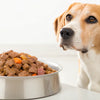Is Wet Food Healthy for Dogs? Understanding the Benefits and Considerations
- Houndsy
Table of Contents
- Introduction
- What is Wet Dog Food?
- Nutritional Benefits of Wet Food
- Potential Drawbacks of Wet Food
- Exploring Mixed Feeding Options
- Conclusion
Introduction
When it comes to our beloved canine companions, one of the most pertinent questions dog owners often face is: Is wet food healthy for dogs? It's a thought-provoking query, especially considering that the right diet is vital for our pets' overall health and happiness. With statistics showing that about 63% of dogs are overweight or obese, nutrition is more critical than ever. This blog post aims to deep dive into the world of dog food, particularly focusing on wet food, and what it means for our furry friends.
In this article, we’ll explore the nuances of wet versus dry dog food, the health benefits and potential drawbacks of feeding wet food, and how it can fit into your dog’s diet. By the end of this exploration, we’ll empower you to make informed nutritional choices for your pet, ensuring their daily feeding experience is not only beneficial but also delightful.
As we unpack this topic, we invite you to reflect on your own dog’s feeding habits. Are there aspects of their diet that could be improved? Could enhancing their meals contribute positively to their health and happiness? Let’s embark on this journey together to understand how wet food can play a role in your dog's diet.
What is Wet Dog Food?
Wet dog food, commonly known as canned food, is typically made up of meat and other ingredients mixed with water or broth, resulting in a high-moisture product. This food can come in various formulations, including pâtés, chunks in gravy, or sliced meats.
The Processing of Wet Dog Food
Understanding how wet dog food is processed can shed light on its nutritional value. The manufacturing process generally involves:
-
Ingredients Preparation: Ingredients, primarily protein sources like beef, chicken, or fish, are ground and mixed with other components, such as grains, vitamins, and minerals.
-
Cooking and Sterilization: After mixing, the mixture is cooked under high pressure to ensure it is safe for consumption. This process helps maintain the nutritional integrity while providing a longer shelf life.
-
Canning: The food is then placed in cans or pouches and sealed to keep it fresh until it's opened.
Due to its high moisture content—often between 75-78%—wet food can offer unique hydration benefits, especially for dogs that tend to drink less water.
Nutritional Benefits of Wet Food
Enhancing Hydration
One of the standout features of wet food is its high water content. For dogs, especially those that may not drink enough water throughout the day, wet food can significantly contribute to their hydration levels.
- Benefits for Specific Health Conditions: For dogs with urinary issues or kidney problems, increasing water intake is essential. Canned food is an excellent solution to keep them hydrated and support their overall health.
Appetite Stimulation
The aroma and texture of wet food are often much more appealing than dry kibble. This aspect is particularly beneficial for:
-
Picky Eaters: If your dog tends to turn their nose up at kibble, incorporating wet food can entice them to eat more consistently. Its rich flavors and moist texture can turn mealtime into an exciting experience.
-
Senior Dogs and Those with Dental Issues: Wet food is easier to chew than dry kibble, making it suitable for older dogs or those suffering from dental problems. The softness allows them to enjoy mealtime without discomfort.
Weight Management and Satiety
Interestingly, wet food has been associated with increased satiety, contributing to weight management for dogs:
-
Filling Meals: The moisture content can help your dog feel fuller for longer, thus potentially aiding in preventing overeating. This is particularly significant for dogs prone to obesity or those on a weight-loss regimen.
-
Nutritional Density: Wet food is usually higher in protein and lower in carbohydrates compared to dry food, helping support weight management by discouraging excessive weight gain.
Potential Drawbacks of Wet Food
While there are numerous advantages to incorporating wet food into your pup's diet, there are also some considerations to take into account:
Cost and Storage
-
Higher Price Point: Wet food tends to be more expensive than dry kibble, especially if fed exclusively. This might not be feasible for some pet owners, necessitating a balanced approach.
-
Storage Challenges: Once opened, wet food must be refrigerated and consumed within a few days to avoid spoilage. The messier nature of wet food can also be an inconvenience, especially for those who prefer the ease of dry kibble.
Dental Health Concerns
While wet food has many benefits, it does not promote dental health like dry food does:
- Tartar Buildup: The chewing action associated with kibble can help reduce tartar buildup, something that wet food does not inherently provide. This can be a concern for dogs that have existing dental issues.
Nutritional Selection
Not all wet food is created equal. It's essential to choose high-quality brands that use real meat and avoid fillers:
- Review Ingredients: Look for products that list named meats as the primary ingredient and avoid those with excessive fillers, artificial preservatives, or by-products.
Exploring Mixed Feeding Options
Blending wet and dry food can sometimes provide the best of both worlds, allowing you to take advantage of the unique benefits of each type.
Benefits of Mixing
- Balanced Nutrition: Mixing can help address any nutritional gaps in your dog’s diet while providing the palatability and moisture of wet food.
- Cost Savings: By combining the two, you can stretch out the wet food usage, making it more economical.
- Flavor Variety: A mixed diet can introduce different tastes and textures to your pet's meals, keeping them excited about food.
How to Transition to a Mixed Diet
If you're considering introducing wet food into your dog’s existing diet, here’s a simple guide:
-
Introduce Gradually: Start by mixing a small amount of wet food with their dry kibble, gradually increasing until you reach the desired ratio.
-
Monitor Reactions: Keep an eye on your dog's digestive health as you transition to ensure that they are adjusting well to the new food.
-
Consult Your Vet: It's always wise to discuss dietary changes with your veterinarian, especially if your dog has specific health conditions or dietary needs.
Conclusion
So, is wet food healthy for dogs? The answer is: it can be a nutritious and beneficial addition to your dog’s diet when selected thoughtfully and integrated appropriately. While it offers hydration, palatability, and benefits for certain health conditions, it is important to be mindful of its drawbacks, including potential dental issues and cost.
As pet owners striving for the best for our furry companions, we are committed to simplifying the feeding experience through quality products. Our Houndsy Kibble Dispenser combines practicality and elegance in a design that enhances your routine while making feeding your dog easier and more enjoyable. By choosing quality food and the right feeding tools, we're one step closer to elevating our dogs' mealtime experience together.
Have you considered how wet food could enhance your dog's diet? Explore our Houndsy Kibble Dispenser for a stylish and convenient solution to simplify your feeding routine while ensuring your dog gets the nutrition they need!
FAQ
Is wet food better for dogs with hydration issues?
Yes, wet food can be beneficial for dogs that don't drink enough water as it contains a high moisture content, which helps keep them hydrated.
Can I feed my dog both wet and dry food?
Absolutely! Many pet owners opt for a mixed feeding approach, which can provide a balanced diet and cater to their dog's taste preferences.
How much wet food should I feed my dog?
The amount depends on your dog's weight, age, and overall health. It’s essential to follow the feeding guidelines on the package and consult your veterinarian for personalized recommendations.
What should I look for in high-quality wet dog food?
High-quality wet dog food should contain real meat as the primary ingredient, minimal fillers, and should not include artificial additives. Always review the nutritional information to ensure it meets your dog's dietary needs.
Can wet food affect my dog's dental health?
Wet food can contribute to faster tartar buildup due to its softer texture, so it's essential to maintain good dental hygiene by providing dental chews or incorporating dry food into their diet as well.













